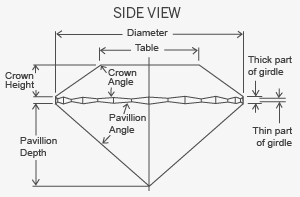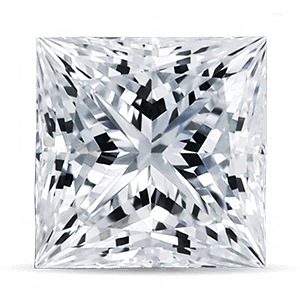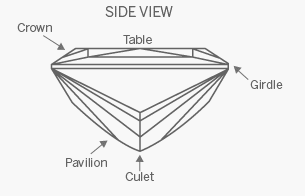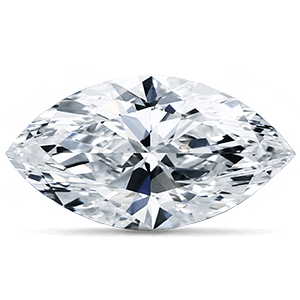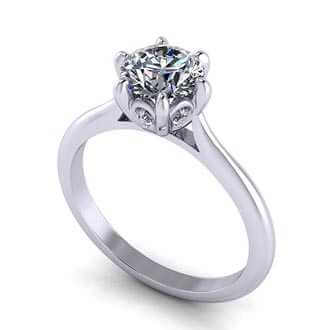Education Center
Round Diamonds
Diamond shape refers to a diamond’s physical form, and is often one of the first attributes that couples consider when shopping for a diamond. While round diamonds are the most popular choice, many couples are also drawn to the distinctive look of non-round, or “fancy shaped” diamonds. Fancy shaped diamonds include princess, cushion, emerald, asscher, radiant, oval, pear, and heart shaped diamonds. Each diamond shape has its own unique characteristics and is cut to different specifications, which impacts the overall look of the stone.
Princess Diamonds
Princess cut diamonds are the second most popular diamond shape. Princess cut diamonds possess the gorgeous sparkle of round brilliant diamonds in a distinctive square shape. They offer a contemporary look and the flexibility to work in almost any style of ring.
Cushion Diamonds
Cushion cut diamonds combine the appeal of a square cut diamond but with soft, rounded edges, lending this shape a romantic feel. This timeless shape is derived from the old mine cut, and has been refined over hundreds of years. Cushion cut diamonds are a beautiful choice for any setting style.
Emerald Diamonds
Emerald cut diamonds are treasured for their elegant silhouette. The shallow pavilion and crown accentuate the clarity of the stone, while the reflective steps enhance the color and luster of the diamond
Asscher Diamonds
The asscher cut features a square shape with cut corners. A high crown with large step cut facets bestows more brilliance than the other popular step cut shape, the emerald shape. Asscher shaped diamonds are sleek and modern in solitaire settings, and their unique shape perfectly complements vintage-inspired styles.
Pear Diamonds
Pear shapes feature a rounded edge tapering to a point at the opposite end. This unique shape flatters fingers and offers a distinctive look. A fusion of the marquise shape and the most popular round brilliant cut, pear shaped diamonds are intended to showcase the sparkle of the diamond, making it important to find a stone with great symmetry.
Radiant Diamonds
The radiant cut diamond combines the silhouette of an emerald cut diamond with the fire and sparkle of a round brilliant cut diamond. Due to its design, this shape requires more carat weight in the depth to maximize brilliance.
Oval Diamonds
The ever-flattering oval shape is symmetrical and exhibits a similar fire and brilliance to round shaped diamonds. A scintillating twist on the classic round brilliant, the elongated shape can create the illusion of larger size. Oval diamonds are highly versatile, remarkably elegant, and distinctive.
Heart Diamonds
The heart shaped diamond is an evocative signifier of true love. They shimmer with two symmetrical halves, creating a bold and romantic look. Heart shaped diamonds are especially popular in Claddagh designs, and offer a distinctive look in any engagement ring setting.
Marquise Diamonds
The marquise shaped diamond features pointed ends with a curved middle for an eye-catching look. With a larger surface area than any other diamond shape, the marquise shape maximizes perceived size and lends a unique look to any setting style.
4C's of Diamond
Until the middle of the twentieth century, there was no agreed-upon standard by which diamonds could be judged. GIA created the first, and now globally accepted standard for describing diamonds: Color, Clarity, Cut and Carat Weight. Today, the 4C's of Diamond Quality is the universal method for assessing the quality of any diamond, anywhere in the world. The creation of the Diamond 4C's meant two very important things: diamond quality could be communicated in a universal language, and diamond customers could now know exactly what they were about to purchase.

Diamond Cut
The skill with which a diamond is cut determines how well it reflects and refracts light. Learn how the balance of precision and craftsmanship unlocks a diamond's unique brilliance and luster.
Color
Color is the natural color or lack of color visible within a diamond. Learn how the amount of color present affects beauty and value.
Clarity
With most diamonds, there is more than meets the eye! Learn how the presence of natural inclusions and blemishes on and within a diamond impacts its appearance and value.
Carat
Carat is the most visually apparent factor when comparing diamonds. Learn how this unique weight scale is used to measure gemstones.
Shop DiamondsAnatomy
While every diamond is exclusive, all diamonds share certain essential features. A diamond’s anatomy, or its basic structure, determines its magnitudes, brilliance, scattering and sparkling. Each part of the diamond has a definite name, and having a simple understanding of how each part contributes to the diamond as a whole will help you find your flawless diamond.

Anatomy
A diamond is consist of the eight main components. They are Width, Table, Crown, Table Spread, Girdle, Pavilion, Depth, and Culet. Below is a brief description of each part of a diamond and its location.
- Diameter: The width of a refined stone, measured from edge to edge.
- Table: The largest polished facet placed on the top of the diamond.
- Crown: The top portion of a diamond extending from the table to the girdle. The crown is made up of bezel facets (crown mains), star facets, upper girdle facets (upper halves), and a table facet.
- Girdle: The exact edge (widest edge) of the diamond where the crown and pavilion meet.
- Pavilion: The lowermost part of a diamond extending from the girdle down to the Culet.
- Depth: The total height of a diamond restrained from the table to the Culet.
- Culet: The small or pointed facet at the very Bottom-most of the diamond.
Before buying a diamond, make sure that you have a basic understanding of a diamond’s anatomy. This will permit you to truly appreciate diamonds and all their complexities, communicate with specialists about a particular diamond, and, most decisively, it will assist you in making a well-thought out decision about which diamond is best for you.
Shop DiamondsCut
The cut of a diamond refers not to its shape, but to the balance of proportion, symmetry and polish achieved by the diamond cutter. The extent of how well the diamond is cut is directly related to the diamond’s overall beauty. When a diamond has been correctly cut, the diamond’s ability to reflect and refract light is greatly enhanced. By understanding the way that light moves through diamond crystals, modern diamond cutters have established a specific set of proportions and angles that are known to harness the diamond’s internal brilliance and to show it in its best light.

Ideal Cut
An Ideal Cut Diamond is a round, brilliant, or princess cut diamond that is cut to ideal proportions and angles, and has excellent polish and symmetry ratings. An Ideal Cut Diamond is perfectly proportioned to refract light, producing that fire and brilliance up through to the table and crown. Luxury Diamonds NYC offers a nice selection of Ideal Cut Diamonds know at True HeartsTM
GIA, considered to be one of the most respected laboratories for grading natural diamonds, uses the following language on their certificates to grade cut for round diamonds: Excellent, Very Good, Good, Fair, Poor. A GIA Excellent cut will be listed as either Ideal or Super Ideal on the site. We use specific diamond characteristics, such as cut grade, polish, and symmetry to distinguish between Ideal and Super Ideal. If a cut grade is not available from a grading laboratory, such as for fancy shaped diamonds, Luxury Diamonds NYC combines the characteristics above along with depth, table, secondary measurements, and subjective factors to assess the cut grade of the diamond.
Shop DiamondsColor
Color refers to the natural body color of a diamond and not to the reflection of spectral colors that flash when a diamond moves. Most diamonds naturally exhibit slight hints of yellow, brown, or gray. This color is caused by natural trace elements of nitrogen that were present when the diamond formed under the Earth’s crust. The less color a diamond exhibits, the higher the rarity, and therefore the higher the value.

Diamond Color
Color of a diamond is a result of diamond’s composition and does not change with time. Colorless diamonds allow light to travel through them as compared to the colored diamonds. These diamonds also emit more fire and sparkle. The process, through which a diamond is formed, is the deciding factor for its color. The whiter the diamond is the higher value it will have. For grading the color of diamonds, jewelers refer to GIA’s color scale that starts the rating with D for the colorless diamonds and grows up to Z as the traces of light yellow or brown color are found in the diamond. Diamonds graded from D to F are amongst the most desirable and valuable stones. These diamonds are a delight for the diamond lovers. Nevertheless, if you have a low budget, you can also find good diamonds with lower grades. These diamonds are not exactly colorless but show no color to untrained eye.
Shop DiamondsClarity
Clarity refers to how clean or clear the diamond is with respect to natural microscopic characteristics that were trapped within or on the diamond while it was forming. Internal characteristics are known as inclusions, and characteristics on the surface of the gem are known as blemishes. Inclusions may be crystals of a foreign material or structural imperfections such as tiny cracks, known as feathers, which can appear whitish or cloudy.

Diamond Clarity
Diamond clarity means finding out characteristics of a diamond, including the blemishes and inclusions. If you consider the pressure that a diamond is created, and that they are not produced in sterile laboratory, you will be not be surprised to find that most of these diamonds are not free of flaws. Usually there are two kinds of flaws found in diamonds – blemishes and inclusions. Inclusions are naturally occurring internal flaws that are found in diamonds including cracks, air bubbles, and mineral. However, most blemishes occur at the time of cutting process.
The diamonds that have less blemishes and inclusions are considered valuable as compared to those that have more. GIA certificates consist of a diamonds inclusion plot, as there is no similarity between two diamonds. The plot of the GIA certificate ensures the worth of the diamond you are planning to buy. It lets you have the assurance that the diamond you are receiving is the one you have paid for. If you are in a fix about what clarity grade you should choose, flawless is the best and rarest clarity grade. Move the slider to view examples of different diamond clarity grades. Click marker for more information.
Shop DiamondsCarat
Carat (ct.) refers to the unique unit of weight measurement used exclusively to weigh gems and diamonds. Carat weight is often confused with visual size even though it is actually a measurement of weight. Depending on the shape and type of gemstone being weighed, the weight will visually show itself differently. For example, a 1.00 ct. round diamond will measure around 6.5mm, and a 1.00 ct. round sapphire will measure around 6.0mm. This is due to the varying density of different gemstones.

Carat Weight
Diamond clarity means finding out characteristics of a diamond, including the blemishes and inclusions. If you consider the pressure that a diamond is created, and that they are not produced in sterile laboratory, you will be not be surprised to find that most of these diamonds are not free of flaws. Usually there are two kinds of flaws found in diamonds – blemishes and inclusions. Inclusions are naturally occurring internal flaws that are found in diamonds including cracks, air bubbles, and mineral. However, most blemishes occur at the time of cutting process.
The diamonds that have less blemishes and inclusions are considered valuable as compared to those that have more. GIA certificates consist of a diamonds inclusion plot, as there is no similarity between two diamonds. The plot of the GIA certificate ensures the worth of the diamond you are planning to buy. It lets you have the assurance that the diamond you are receiving is the one you have paid for. If you are in a fix about what clarity grade you should choose, flawless is the best and rarest clarity grade. Move the slider to view examples of different diamond clarity grades. Click marker for more information.
Shop Diamonds
What is a Diamond Certificate?
A diamond certificate verifies each diamond’s specifications, including its color grade, carat weight, clarity grade and cut grade. You should never buy a diamond without a diamond certificate. The most well-known grading laboratories are the Gemological Institute of America (GIA) and the American Gem Society (AGS) and the International Gemological Institute (IGI).
A diamond's cost depends upon objective characteristics popularly known as the 4C's: Color, Clarity, Cut and Carat. The relationship between these four characteristics determines the value of a diamond. Although it is commonly assumed that carat is the most important member of the 4C's, color, cut and clarity have a much greater impact on the appearance of a diamond.
Shop Certified DiamondsDiamond Care
Depending on the setting you choose, you can soak your diamond engagement and/or wedding rings for up to 30 minutes in a solution of dish washing liquid and water. This is best suited to prong and cathedral settings. In pave and basket settings, however, soaking the rings can increase the likelihood of the gems coming loose. Be mindful of this when you decide to soak any jewelry piece use mild dish soap in warm water and soak your jewelry for a few minutes. Using a soft cloth or cotton swab, gently scrub the metal (gold, platinum, silver) and then rinse. Repeat the process if necessary, but always proceed with caution when it comes to soaking jewelry.
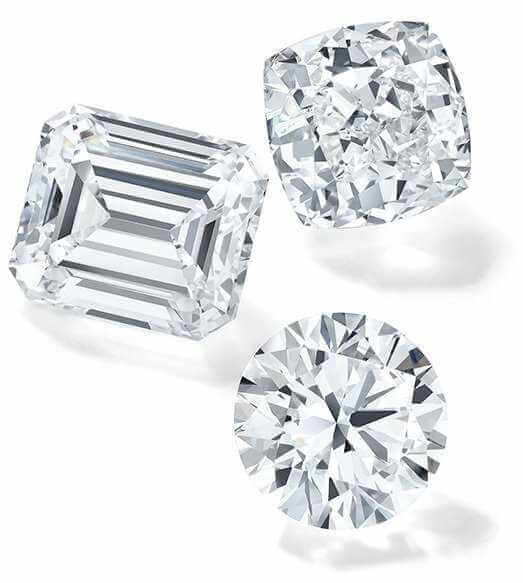
Cleaning your Diamond Jewelry
You can use toothpicks to remove dirt that is lodged in between the prongs and the diamonds, but be extra careful not to scratch the metal or move the positioning of a prong. If fibers from cloth get stuck in the setting, gently use tweezers to remove them. Again, be careful of the metal. Even though diamonds can only be scratched by other diamonds, the precious metals into which they are set can be scratched more easily.
When storing your diamond jewelry, be sure to keep it separate from other jewelry. Remember that diamonds can not only scratch any other jewelry you have, but can scratch each other as well. Make sure that two diamond pieces are not being stored in such a way that they touch each other.
Shop DiamondsRing Type
One advantage of buying your engagement ring from an online jeweler is the expanded access you get to ring styles. Here we offer almost every ring style imaginable – and if we don’t have a style you want, we can custom design a ring for you. To choose the perfect ring, consider what fits her lifestyle and personality best. In addition to your budget, her personal style and her daily activities are the main considerations that should guide your selection of a setting. Here are recommendations that match personality traits with various styles of engagement rings:
Setting Types
We offer a broad range of settings, but we’ll help you narrow down the options by taking into account the style preferences, lifestyle, and personality of your partner.
Ring Sizing
Your engagement ring should fit easily — not very tight, yet not very free either. The ideal ring fits free enough to slide over your knuckle and tight enough that it can't tumble off your finger. To discover your ring size, you can utilize our internet ring sizer or demand a free plastic ring sizer. Keep reading for tips on the best way to gauge your finger measure and ensure that you buy a ring that fits perfectly.
Metal
Diamonds come in many different shapes. Each diamond shape possesses its own unique qualities, so exploring and learning about the various shapes is worth your while.
Heart Shapes
Diamonds come in many different shapes. Each diamond shape possesses its own unique qualities, so exploring and learning about the various shapes is worth your while.
Marquise Shapes
Diamonds come in many different shapes. Each diamond shape possesses its own unique qualities, so exploring and learning about the various shapes is worth your while.
Wedding Ring Guide
There are many different styles of wedding rings to choose from, including plain gold or platinum rings, diamond rings, sapphire rings, and eternity rings.
Engraving
For both brides and grooms, personalized engraving—typically on the inside of the band—is a sweet and sentimental way to add a special touch to wedding rings. You can choose to engrave with your monogram, wedding date, a special saying, or even a fingerprint. The length of the engraving depends on the ring size and type of ring.
Finding The Perfect Wedding Ring
Every bride has an idea of what ring she wants and, if possible, the ring that he'll be wearing too. If your man is hesitant about wearing a ring, then put aside your plans for matching bands. Though having rings that match can be a wonderful public expression of your love for each other, that shouldn't be a critical point. Many men find rings to be uncomfortable, so if your platinum round pave set diamond wedding ring doesn't come in an equivalent ring for him, don't fret - wear the ring you want and let him pick out the ring that he likes.
Necklaces
The perfect necklace or pendant will add style to anything she wears. In addition to being a stylish gift, giving her a necklace offers you the chance to perform the classically romantic gesture of putting it around her neck for the first time. In general, a necklace is defined as slightly type of chain or length of valuable metal or gems. They are also available in pendant styles that feature a single diamond, gemstone, fine metal design, or pearl, generally suspended from a chain. A pearl strand is a measurement of closely threaded pearls.
Necklace Type

Metal Chains
Chains go with everything. A fine platinum chain in a choker length will add just a touch of luster.
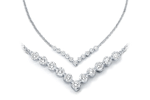
Necklaces
Necklaces come in a variety of styles including heavier chains, links, and braids. Some necklaces feature a fixed set of diamonds or gemstones, where others have stones that run their whole length.

Pearl strands
Pearl strands are an important element to a woman's jewelry wardrobe. She can wear one with a dress to create a elegant look.

Solitaire Pendant
The simple design of a solitaire pendant allows all the devotion to focus on a stunning diamond, pearl, or gemstone. These timeless pieces can be worn with a dress or with denims.
Bracelets
A bracelet is one jewelry item she will see all the time, so she can appreciate it often. She also enjoys the feeling of it on her wrist reminding her of you.
Some bracelets are available in different lengths. So before you purchase, be sure to measure one of her other bracelets to be sure she doesn't need a special length.
Bracelets are usually worn on occasions when she isn't working with her hands. Even when not working, a bracelet's proximity to the hands causes it to get bumped and banged, so it must be very durable. Jewelry designers take this into account, so you can be sure the bracelet you choose will last.
Bracelet Types

Chains
This is the exemplary bracelet. You'll discover an assortment of chain structures, similar to the conventional round-interface rolo or wheat chain, in an assortment of metals like sterling silver, 18k gold, and platinum.

Bangle
A bangle bracelet can be worn for a basic look or can be joined with a few different bangles. Bangles draw the eye with metallic sparkle, and a few bangles clinking together make a wonderful sound.

Pearl
A pearl bracelet is a traditional piece of jewelry. It adds a dressy touch to anything she wears, from pants to a party gown. Or on the other hand she can formalize the look with a coordinating pearl accessory and studs.
Earrings
Earrings make the ideal blessing since they are consistently the correct fit. The most essential gems closet piece, she may go out without a bracelet, however she's quite often wearing earrings.
Most earrings styles go with anything, adding style to anything she wears. The wide variety of earring types, sizes, and costs accessible makes it simple to find the ideal pair for a blessing. She'll remember you each time she wears them.
Earrings Types
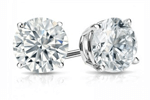
Studs
Since they're little, stud hoops are anything but difficult to wear. They go as effectively with a party dress as they do with pants. You'll discover an assortment of styles in Cultured Pearl Earrings, Diamond Earrings and Gemstone Earrings.

Drops
Drop earrings are made to dangle underneath their setting. Swaying with movement, they can include an exquisite touch. Pearl, precious stone, and gemstone drop studs are accessible in different settings.

Hoops
Platinum, gold, or silver hoops give a female touch, and valuable metals go with anything. For included shimmer, pick a couple with diamonds.

Gemstones
Gemstones are mined from the Earth’s crust. These gorgeous rocks are available in every virtually imaginable color. These beautiful minerals infuse fine jewelry to give it a natural brilliance. These are categorized based on their characteristics, chemical composition, lustre, availability, color, inclusions, rarity and demand as precious or semi-precious. Their aesthetic value makes them attractive which, makes them a perfect choice for jewelry. Gemstones can be set in with a pair of earrings, a bracelet, an engagement ring, a necklace, etc. Before putting them to use, they need to be cut and polished. Moreover, since ancient times, gemstones have been recognized as birthstone for each month and are a symbol to commemorate special events and milestones. The most popular gemstones are Sapphire, Ruby, Emerald, Topaz, Tanzanite, Amethyst, Opal, Peridot, Citrine, Aquamarine, etc.

Sapphire
Renowned for its rich variation in different colors and hues, the name derives from Latin sapphirus, meaning blue, although they exist in many others colors like yellow, green, pink, black, brown, and grey. Blue is the most popular and the most associated color with sapphire. These colors are created by variations in minerals like titanium, iron, and chromium.
The highest quality sapphires are mined and found in India, Myanmar. Cambodia, Thailand, Vietnam, Madagascar, Australia, Montana, Brazil, Tanzania, and North Carolina are some countries where sapphires can be found and extracted. The Mohs’ scale measures the hardness of precious gemstones. 9.00 on the Mohs scale makes them the second hardest substance on Earth after diamond.
Sapphires are a popular choice for a special occasion as it symbolizes commitment, happiness, serenity, and romance. Sapphires can be set in an engagement ring, tennis bracelet, or earrings.
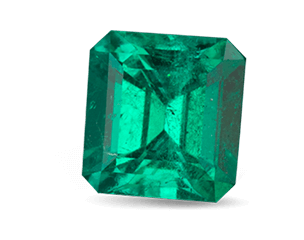
Green Emeralds
Its striking green color makes the emerald a very attractive and popular gemstone for rings and fine jewelry. Emeralds derives its name from the Greek word smaragdus, meaning green gem. It belong s to the mineral family of Beryl that also includes Aquamarines. The color of emerald comes from a small amount of naturally occurring chromium. The color, cut, clarity, and size of an emerald determine its value.
The history of emeralds suggests its mining began in Egypt as emeralds were buried with mummies to preserve the spirits of the dead. Today, the best quality emeralds are found in Columbia, Brazil, Nigeria, Tanzania, Zambia, Afghanistan, Somalia, South Africa, Spain, Switzerland, Madagascar and some parts of the United States. The Colombian mines of Muzo, Coscuez, and Chivor being the most famous, followed by Zambia.
Emeralds are the birthstone for the month of May. These beautiful stones represent love, prosperity, and overall happiness. It measures 7.5 to 8 on the Moh’s Scale. The bright and vivid green color emeralds are the most valuable.

Red Rubies
Ruby is named from the Latin word Ruber, meaning red. Rubies are available in a diverse range of hues ranging from near-burgundy to pale pink. The variation in its color determines its price. The darker and brighter the stone, the more costly it will be. Ruby's price can also be determined by other considerations such as clarity, cut, and size of the ruby.
Although the stone is popularly mined in Myanmar, Sri Lanka, Tanzania, Vietnam, Mozambique, Thailand, and Kenya, various parts of the United States are some other locations of the world that produce Ruby. Some rubies are priced higher than diamonds and are the most expensive rubies. These are said to come from Burma and are called Burmese rubies.
Ruby is the birthstone for the month of July. Rubies add a striking complement when set in an engagement ring or worn in earrings or a pendant. Sapphires and Rubies are both from the corundum family. Rubies represent love and passion and is believed to provide energy and enthusiasm.

Gemstone Anatomy
The valuation of a gemstone is done using the 4C’s. The 4C’s are carat, cut, color, and clarity. Having a proper understanding of the 4C’s is vital before buying them. The 4C’s will help in examining the correct value of a gemstone.

Clarity
The clarity of a gemstone refers to its internal and external flaws. The fewer inclusions it will contain, the better grading it will have, and the more valuable the colored stone will be. The clarity of a gemstone depends on its type. Very clear stones are graded- AAA clarity, and semi clean stones are of AA clarity. Some gemstones of the highest possible quality are graded- AAAA.
Tiny crystals of a mineral, small gas bubbles, minute liquid filled pockets, internal fractures or cleavages, or any other matter visible inside the stone is an inclusion. Any external factors like scratches, abrasions, chips or spots are blemishes.
The cost of a diamond is highly affected by inclusion. Some flaws in a gemstone are even visible to the eye. Gemstone grading is not as rigid as diamond grading.

Cut
The cut is one of the most important elements in determining the value of a gemstone. The shape of a diamond is its cut. There are various gemstone shapes available like rounds, ovals, hearts, marquise, cushions, pears, emerald or octagonal cut hexagons, half-moons, triangles, and carved gems. A gemstone is graded in four levels- excellent, very good, good, and fair. An excellent cut will reflect on a gemstone's quality. The excellent cut has minimum visible inclusions and extremely deep color that increases its overall visual appearance.
Achieving l00% brilliance may not be the final goal of cutting gemstones. Several variables affect the cut of colored stone. If a gemstone is too dark, it is cut shallow, and a shallow cut provides a better color to the gemstones. Deep color can also affect the brilliance of a gemstone as light is absorbed rather than being reflected in extremely dark colored stones. When it comes to very light-coloured stones, the cut is very deep to enhance the overall color of the gemstone.

Color (Hue-tone-saturation)
Each gemstone has a unique distinguishing color. Color is a crucial factor that affects the price of a colored stone. For better analysis, it is essential to understand different color parameters. A gemstone says sapphire can have a different color intensity, shade, purity, saturation and tone. Hue, tone and saturation are three main parameters used for determining the color of a gemstone.
Hue represents the primary color of the gemstone. Identifying hues is very easy. The tone of the colored stone helps identify the intensity of the color from light to dark. Ideally, some color tones look more appealing than others as per the design and the setting of the jewelry. This can vary at times depending on a person’s taste and preference.
Saturation describes the intensity of the color present, that is, how much color there is. The most expensive gemstones have the most color saturation. The price of a colored stone can fall if the saturation is low. The brighter the emerald (green), the higher the price.

Carat Weight (Size)
Carat is the unit of measurement used for weighing a gemstone. Carat weight is one-fifth of a gram, which is 0.2 grams. One-fifth of a gram would be the weight of a paperclip. Carat should not be confused with karat (10K, 18K), which refers to the purity of gold. Nowadays, gemstones are weighed using an electronic digital scale. There are a variety of stones available in the market, and all these colored stones possess different densities (mass per unit amount). Two similar-sized, identical gemstones might differ in their weights.


















